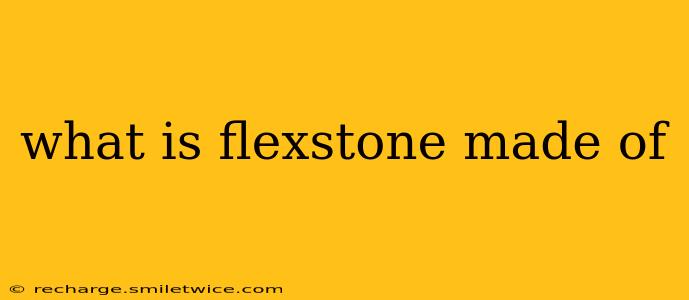Flexstone, a popular choice for countertops and other surfaces, is a composite material known for its durability, aesthetic appeal, and relative affordability. But what exactly is it made of? Understanding its composition is key to appreciating its properties and potential applications. This comprehensive guide will explore the ingredients of Flexstone, comparing it to similar materials, and addressing common questions surrounding its manufacture and performance.
What are the main components of Flexstone?
Flexstone's precise formulation can vary slightly depending on the manufacturer, but the core ingredients remain consistent. It's primarily a blend of polymeric resins (like acrylic or polyester resins), mineral fillers, and pigments. Let's break these down:
-
Polymeric Resins: These form the binding agent, holding the material together and giving it its characteristic flexibility and strength. Acrylic resins are often favored for their superior durability, scratch resistance, and ability to create a smooth, non-porous surface.
-
Mineral Fillers: These are typically crushed stone, quartz, or other inert minerals that add bulk, strength, and texture to the material. The type and amount of filler influence the overall appearance, density, and cost of the final product. This is where manufacturers can differentiate their offerings, resulting in variations in price and performance.
-
Pigments: These are added to achieve a wide range of colors and patterns. High-quality pigments ensure that the color remains vibrant and resistant to fading over time.
How does Flexstone compare to other countertop materials?
Flexstone occupies a middle ground in the countertop market, offering a balance between cost, durability, and aesthetics. Unlike natural stone (granite, marble), it doesn't have the inherent variations in veining and color. However, it offers a wider array of consistent colors and patterns compared to solid surface materials. Compared to laminate, it boasts significantly greater durability and resistance to heat and stains. In essence, it's engineered to offer the visual appeal of natural stone with the enhanced practicality of man-made materials.
Is Flexstone durable? How resistant is it to scratches and stains?
Yes, Flexstone is known for its durability. The polymeric resins provide a protective layer against scratches and impact damage. The non-porous nature of the material also makes it highly resistant to stains, preventing liquids from seeping into the surface. Proper care and maintenance will further enhance its longevity. However, it's important to note that while resistant, Flexstone isn't indestructible. Excessive force or exposure to extremely harsh chemicals could cause damage.
What are the benefits of using Flexstone?
Several advantages make Flexstone a popular choice for various applications:
- Affordability: Compared to some natural stone options, Flexstone is generally more cost-effective.
- Durability: It's resistant to scratches, stains, and heat.
- Variety of Colors and Patterns: Manufacturers offer a wide selection of styles to match different design aesthetics.
- Easy to Clean and Maintain: Its non-porous surface simplifies cleaning and upkeep.
- Seamless Installation: Flexstone can be seamlessly integrated into various applications, ensuring a smooth, continuous surface.
What are the disadvantages of using Flexstone?
While Flexstone boasts many advantages, it's crucial to acknowledge potential drawbacks:
- Not as Heat-Resistant as Some Materials: While resistant, prolonged or extreme heat exposure can potentially damage it. Use of trivets is recommended.
- Susceptibility to Deep Scratches: While scratch-resistant, deep gouges from sharp objects might be difficult to repair.
- Potential for Discoloration with Harsh Chemicals: Avoid using abrasive cleaners or strong chemicals to prevent discoloration or dulling.
How is Flexstone manufactured?
The manufacturing process involves combining the polymeric resins, mineral fillers, and pigments in precise proportions. This mixture is then poured into molds or formed into sheets using various techniques. The material is then cured under controlled conditions to ensure proper hardening and bonding. The exact procedures can vary depending on the manufacturer and specific product.
This comprehensive overview offers a deeper understanding of Flexstone's composition, properties, and applications. Remember that the specifics might vary slightly depending on the manufacturer, so always refer to the manufacturer's specifications for your chosen product.
